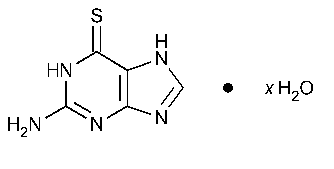Thioguanine
6H-Purine-6-thione,2-amino-1,7-dihydro-.
2-Aminopurine-6(1H)-thione [154-42-7].
Hemihydrate 176.20 [5580-03-0].
»Thioguanine is anhydrous or contains one-half molecule of water of hydration.It contains not less than 97.0percent and not more than 100.5percent of C5H5N5S,calculated on the dried basis.
Packaging and storage—
Preserve in tight containers.
Labeling—
Label it to indicate its state of hydration.
Identification—
A:
Infrared Absorption á197Kñ.
B:
The UVabsorption spectrum of a 1in 200,000solution of it,prepared as directed in the Assay,exhibits maxima and minima at the same wavelengths as that of a similar solution of USP Thioguanine RS,concomitantly measured.
Loss on drying á731ñ—
Dry it in vacuum at 105 for 5hours:it loses not more than 6.0%of its weight.
for 5hours:it loses not more than 6.0%of its weight.
Selenium á291ñ:
0.003%,200mg being used for the test.
Phosphorous-containing substances—
Ammonium molybdate solution—
Dissolve 8.3g of ammonium molybdate in 40mLof water,add 33mLof dilute sulfuric acid (2in 7),dilute with water to 100.0mL,and mix.This solution is stable for about two weeks.
Procedure—
Transfer 50.0mg,accurately weighed,to a large test tube,add 1mLof dilute sulfuric acid (2in 7),and heat in a boiling water bath for 5minutes.Cautiously add nitric acid,dropwise,continue heating until the mixture becomes colorless,and then heat for 1minute longer.Cool,dilute with water to about 10mL,and transfer the solution to a 25-mLvolumetric flask with the aid of a few mLof water.To the flask add 0.75mLof Ammonium molybdate solutionand 1.0mLof aminonaphtholsulfonic acid TS,dilute with water to volume,and mix.Determine the absorbance of this solution in a 1-cm cell,with a suitable spectrophotometer,at a wavelength of about 620nm,using a reagent blank to set the instrument:the absorbance is not greater than that produced by 1.5mLof a similar solution of monobasic potassium phosphate in water having a known concentration of 10µg of phosphate (PO4)in each mL,concomitantly measured (0.03%as phosphate).
Free sulfur—
Dissolve 50mg in 5mLof 1Nsodium hydroxide:the solution is clear.
Organic volatile impurities,Method Vá467ñ:
meets the requirements.
Solvent—
Use dimethyl sulfoxide.
Nitrogen content—
Determine the nitrogen content as directed under Nitrogen Determination,Method IIá461ñ,using about 100mg,accurately weighed.Each mLof 0.1Nsulfuric acid is equivalent to 1.401mg of N.Not less than 40.6%and not more than 43.1%,calculated on the dried basis,is found.
Assay—
Transfer about 100mg of Thioguanine,previously dried and accurately weighed,to a 100-mLvolumetric flask,dissolve in a mixture of 15mLof water and 1.5mLof 1Nsodium hydroxide,dilute with water to volume,and mix.Transfer 10.0mLof this solution to a second 100-mLvolumetric flask,add dilute hydrochloric acid (1in 100)to volume,and mix.Finally,transfer 5.0mLof the last solution to a third 100-mLvolumetric flask,then add dilute hydrochloric acid (1in 100)to volume,and mix.Concomitantly determine the absorbances of this solution and a solution of USP Thioguanine RS,in the same medium,having a known concentration of about 5µg per mL,in 1-cm cells at the wavelength of maximum absorbance at about 348nm,with a suitable spectrophotometer,using dilute hydrochloric acid (1in 100)as the blank.Calculate the quantity,in mg,of C5H5N5Sin the portion of Thioguanine taken by the formula:
20C(AU/AS),
in which Cis the concentration,in µg per mL,of USP Thioguanine RSin the Standard solution,and AUand ASare the absorbances of the solution from Thioguanine and the Standard solution,respectively.
Auxiliary Information—
Staff Liaison:Lawrence Evans,III,Ph.D.,Scientist
Expert Committee:(PA6)Pharmaceutical Analysis 6
USP28–NF23Page 1914
Phone Number:1-301-816-8389
